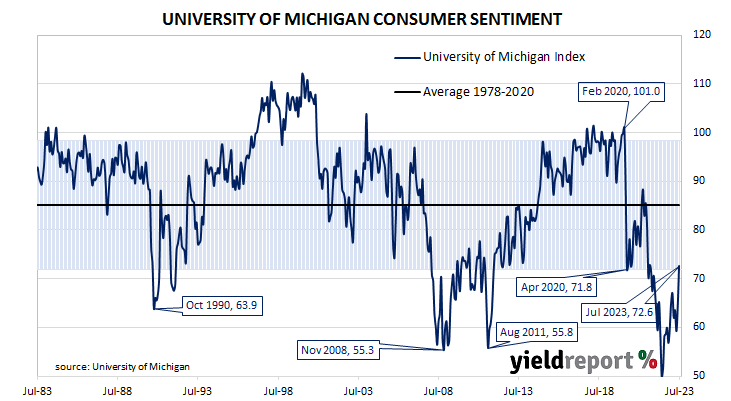Summary: University of Michigan consumer confidence index improves again, well-above expectations; views of present conditions, future conditions improve; sentiment improves for all demographic groups except lower-income consumers; ANZ: difficult to put comforting spin on lift in 1-year-ahead inflation expectations.
US consumer confidence started 2020 at an elevated level but, after a few months, surveys began to reflect a growing unease with the global spread of COVID-19 and its reach into the US. Household confidence plunged in April 2020 and then recovered in a haphazard fashion, generally fluctuating at below-average levels according to the University of Michigan. The University’s measure of confidence had recovered back to the long-term average by April 2021 but then it plunged again in the September quarter and then remained at historically low levels through 2022 and first half of 2023.
The latest survey conducted by the University indicates confidence among US households has improved on average for a second consecutive month, albeit to a low level. The preliminary reading of the Index of Consumer Sentiment registered 72.6 in July, well-above the generally expected figure of 65.5 as well as June’s final figure of 64.4. Consumers’ views of current conditions and future conditions both improved relative to those held at the time of the June survey.
“Overall, sentiment climbed for all demographic groups except for lower-income consumers,” said the University’s Surveys of Consumers Director Joanne Hsu. “The sharp rise in sentiment was largely attributable to the continued slowdown in inflation along with stability in labour markets.”
US Treasury bond yields rose on the day. By the close of business, the 2-year Treasury yield had gained 9bps to 4.74%, the 10-year yield had added 6bps to 3.83% while the 30-year yield finished 3bps higher at 3.93%.
In terms of US Fed policy, expectations of a lower federal funds rate in the first half of 2024 softened. At the close of business, contracts implied the effective federal funds rate would average 5.115% in July, 4bps more than the current spot rate, and then increase to an average of 5.31% in August. December futures contracts implied a 5.365% average effective federal funds rate while June 2024 contracts implied 4.735%, 35bps less than the current rate.
“The fall in consumer confidence as inflation has risen has overstated the weakness in retail, and any rise that’s related to the anticipated fall in headline inflation is corresponding likely to overstate the impetus to spending,” said ANZ rates strategist Gregorius Steven. “However, it’s difficult to put any comforting spin on the lift in US household 1-year-ahead inflation expectations from 3.3% to 3.4% when the consensus had been for a fall, and the key longer-run expectations measure also ticked higher.”
It was once thought less-confident households are generally inclined to spend less and save more; some decline in household spending could be expected to follow. However, recent research suggests the correlation between household confidence and retail spending is quite weak.


